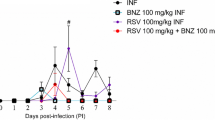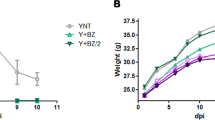Abstract
Chagas disease is an acute or chronic illness that causes severe inflammatory response, and consequently, it may activate the inflammatory cholinergic pathway, which is regulated by cholinesterases, including the acetylcholinesterase. This enzyme is responsible for the regulation of acetylcholine levels, an anti-inflammatory molecule linked to the inflammatory response during parasitic diseases. Thus, the aim of this study was to investigate whether Trypanosoma cruzi infection can alter the activity of acetylcholinesterase and acetylcholine levels in mice, and whether these alterations are linked to the inflammatory cholinergic signaling pathway. Twenty-four mice were divided into two groups: uninfected (control group, n = 12) and infected by T. cruzi, Y strain (n = 12). The animals developed acute disease with a peak of parasitemia on day 7 post-infection (PI). Blood, lymphocytes, and brain were analyzed on days 6 and 12 post-infection. In the brain, acetylcholine and nitric oxide levels, myeloperoxidase activity, and histopathology were analyzed. In total blood and brain, acetylcholinesterase activity decreased at both times. On the other hand, acetylcholinesterase activity in lymphocytes increased on day 6 PI compared with the control group. Infection by T. cruzi increased acetylcholine and nitric oxide levels and histopathological damage in the brain of mice associated to increased myeloperoxidase activity. Therefore, an intense inflammatory response in mice with acute Chagas disease in the central nervous system caused an anti-inflammatory response by the activation of the cholinergic inflammatory pathway.





Similar content being viewed by others
References
Tartarotti E, Oliveira-Azeredo MT, Ceron CR (2004) Problemática Vetorial Da Doença De Chagas. Arq Ciênc Saúde 11(1):44–47
Pinto Dias JC (2013) Human chagas disease and migration in the context of globalization: some particular aspects. J Trop Med 2013(789758):1–9
Drumon JAG, Marcopito LF (2006) Internal migration and distribution of chagas disease mortality, Brazil, 1981–1998. Cad de Saúde Pública 22(10):2131–2140
Nisimura LM, Estato V, Souza EM et al (2014) Acute chagas disease induces cerebral microvasculopathy in mice. PLoS Negl Trop Dis 8(7):1–9
Da Silva AS, Pimentel VC, Fiorenza AM et al (2011) Activity of cholinesterases and adenosine deaminase in blood and serum of rats experimentally infected with Trypanosoma cruzi. Ann Trop Med Parasitol 105(5):385–391
Wolkmer P, Traesel CK, Franscicato C et al (2010) Trypanosoma evansi: cholinesterase activity in acutely infected Wistar rats. Exp Parasitol 125:151–255
Borovikova LV, Ivanova S, Zhang M et al (2000) Vagus nerve stimulation attenuates the systemic inflammatory response to endotoxin. Nature 405:458–462
Soreq H, Seidman S (2001) Acetylcholinesterase new roles for an old actor. Nat Rev Neurosci 2(4):294–302
Das UN (2007) Acetylcholinesterase and butyrylcholinesterase as possible markers of low-grade systemic inflammation. Med Sci Monit 13(12):214–221
Pavlov VA, Tracey KJ (2005) The cholinergic anti-inflammatory pathway. Brain Behav Immun 19:493–499
Cardoso MS, Reis-Cunha JL, Bartholomeu DC (2015) Evasion of the Immune Response by Trypanosoma cruzi during Acute Infection. Front Immunol 6(659):1–15
Silva LH, Nussenzweig V (1953) Sobre uma cepa de Trypanosoma cruzi altamente virulenta para camundongo branco. Folia Clin Biol 20:191–207
Brener Z (1962) Therapeutic activity and criterion of cure in mice experimentally infected with Trypanosoma cruzi. Rev Inst Med Trop Sao Paulo 4:386–396
Böyum A (1968) Isolation of mononuclear cells and granulocytes from human blood. Isolation of mononuclear cells by one centrifugation, and of granulocytes by combining centrifugation and sedimentation at 1g. Scand J Clin Lab Invest Suppl 452:77–89
Bradford MM (1976) A rapid and sensitive method for quantification of microgram quantities of protein utilizing the principle of protein dye binding. Anal Biochem 72:248–254
Ellmann GL, Courtney KD, Andres V, Featherstone RM (1961) A new and rapid colorimetric determination of acetylcholinesterase activity. Biochem Pharm 7:88–95
Worek F, Mast U, Kiderlen D et al (1999) Improved determination of acetylcholinestrase activity in human whole blood. Clin Chim Acta 288:73–79
Fitzgerald BB, Costa LG (1993) Modulation of muscarinic receptors an acetylcholinesterase activity in lymphocytes and brain areas following repeated organophosphate exposure in rats. Fundam Appl Toxicol 20:210–216
Rocha JBT, Emanuelli T, Pereira ME (1993) Effects of early undernutrition on kinetic parameters of brain acetylcholinesterase from adult rats. Acta Neurobiol Exp 53:431–437
Sorial ME, El Sayed NSED (2017) Protective effect of valproic acid in streptozotocin-induced sporadic Alzheimer’s disease mouse model: possible involvement of the cholinergic system. Naunyn Schmiedebergs Arch Pharmacol 390(6):581–593
Suzuki K, Ota H, Sasagawa S et al (1983) Assay method for myeloperoxidase in human polymorphonuclear leukocytes. Anal Biochem 132:345–352
Miranda KM, Espey MG, Wink DA (2001) A rapid, simple spectrophotometric method for simultaneous detection of nitrate and nitrite. Nitric Oxide 5(1):62–71
Silman I, Sussman J (2005) Acetylcholinesterase: classical and non classical functions and pharmacology. Curr Opin Pharmacol 5:293–302
Baldissera MD, Bottari NB, Mendes RE et al (2015) Activity of cholinesterases, pyruvate kinase and adenosine deaminase in rats experimentally infected by Fasciola hepatica: influences of these enzymes on inflammatory response and pathological findings. Pathol Res Pract 211(11):871–876
Da Silva AS, Monteiro SG, Gonçalves JF et al (2011) Acetylcholinesterase activity and lipid peroxidation in the brain and spinal cord of rats infected with Trypanosoma evansi. Vet Parasitol 175:237–244
Pavlov VA, Tracey KJ (2006) Controlling inflammation: the cholinergic anti-inflammatory pathway. Biochem Soc Trans 34(6):1037–1040
Robbins TW (2005) Chemistry of the mind: neurochemical modulation of prefrontal cortical function. J Comp Neurol 493:140–146
Kawashima K, Fujii T (2003) The lymphocytic cholinergic system and its contribution to the regulation of immune activity. Life Sci 74:675–696
Nizri E, Hamra-Amitay Y, Sicsic C et al (2006) Anti-inflammatory properties of cholinergic up-regulation: a new role for acetylcholinesterase inhibitors. Neuropharmacology 50:540–547
Adams LB, Hibbs JB, Taintor RR, Kraheenbuhl JL (1990) Microbiostatic effect of murine-activated macrophages for Toxoplasma gondii: role for synthesis of inorganic nitrogen from L-arginine. J Immunol 144:2725–2729
Keita M, Vincendeau P, Buguet A et al (2000) Inducible nitric oxide synthase and nitrotyrosine in the central nervoussystem of mice chronically infect. Exp Paras 95(1):19–27
Da Silva AS, Paim CF, Santos RCV et al (2012) Nitric oxide level, protein oxidation and antioxidant enzymes in rats infected by Trypanosoma evansi. Exp Paras 132:166–170
Da Silva AS, Monteiro SG, Gonçalves JF et al (2011) Trypanosoma evansi: immune response and acetylcholinesterase activity in lymphocytes from infected rats. Exp Paras 127:475–480
Sousa GR, Gomes JA, Fares RC et al (2014) Plasma cytokine expression is associated with cardiac morbidity in chagas disease. PLoS ONE 9(3):1–9
Vasconcelos RH, Azevedo Ede A, Diniz GT et al (2015) Interleukin-10 and tumour necrosis factor-alpha serum levels in chronic Chagas disease patients. Parasite Immunol 37(7):376–379
Rodríguez-Angulo H, Marques J, Mendoza I et al (2017) Differential cytokine profiling in Chagasic patients according to their arrhythmogenic-status. BMC Infect Dis 17(221):1–10
Klebanoff SJ (1999) Myeloperoxidase. Proc Assoc Am Phys 111(5):383–389
Klebanoff SJ, Rosen H (1978) The role of myeloperoxidase in the microbicidal activity of polymorphonuclear leukocytes. Ciba Found Symp 6–8(65):263–284
Klebanoff SJ (2005) Myeloperoxidase: friend and foe. J Leukoc Biol 77:598–625
Acknowledgements
The authors offer their thanks to Professor Mario Steindel from the Protozoology Laboratory of Universidade Federal de Santa Catarina (UFSC) for providing the T. cruzi strain used in this study. The authors also thank The funding agency CNPq for the research productivity Grants and financial resource.
Author information
Authors and Affiliations
Corresponding author
Ethics declarations
Conflict of interest
The authors have declared no conflict of interest.
Ethical approval
The present study was approved by the Ethics Committee for Use of Animals (CEUA) of the Universidade Federal de Santa Maria (UFSM) under protocol number 3960110915.
Rights and permissions
About this article
Cite this article
Silva, A.D., Bottari, N.B., do Carmo, G.M. et al. Chagas disease: modulation of the inflammatory response by acetylcholinesterase in hematological cells and brain tissue. Mol Cell Biochem 438, 59–65 (2018). https://doi.org/10.1007/s11010-017-3113-y
Received:
Accepted:
Published:
Issue Date:
DOI: https://doi.org/10.1007/s11010-017-3113-y




